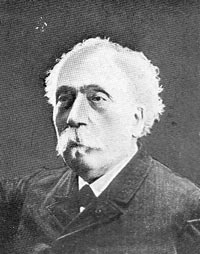Benjamin Baillaud facts for kids
Quick facts for kids
Benjamin Baillaud
|
|
|---|---|
 |
|
| Born |
Édouard Benjamin Baillaud
14 February 1848 Chalon-sur-Saône, Bourgogne-Franche-Comté, France
|
| Died | 8 July 1934 (aged 86) |
| Nationality | French |
| Alma mater | École Normale Supérieure University of Paris |
| Occupation | Astronomer |
| Awards | Bruce Medal (1923) |
Édouard Benjamin Baillaud (born February 14, 1848 – died July 8, 1934) was an important French astronomer. Astronomers are scientists who study stars, planets, and everything else in space. Baillaud was known for his work at several big observatories and for helping to set up how we tell time around the world.
Contents
Benjamin Baillaud's Life and Work
Early Life and Education
Benjamin Baillaud was born in a town called Chalon-sur-Saône in France. He went to two very important schools: the École Normale Supérieure and the University of Paris. After finishing his studies, he started working at the famous Paris Observatory in 1872.
Leading the Toulouse Observatory
From 1878 to 1907, Baillaud was the director of the Toulouse Observatory. During this time, he also worked as the Dean of the Science Faculty at the University of Toulouse. He made the observatory much bigger and better.
He was very excited about a huge project called the Carte du Ciel, which means "Map of the Sky." This project aimed to create a complete map of the entire sky using photographs. Baillaud was also an expert in celestial mechanics. This is the study of how planets, moons, and other space objects move. He especially studied the movements of Saturn's moons.
Building an Observatory on a Mountain
In 1903, the Toulouse Observatory took over a place on the Pic du Midi mountain in the Pyrenees. This mountain is very high, about 2,865 meters (9,400 feet) tall! People had tried to put a telescope there since the 1850s, but it was very hard because of the height.
Baillaud organized a team of soldiers to help. They worked hard to set up two telescopes on the mountain top. One was a large reflecting telescope and the other was a smaller refracting telescope. This was a big achievement because of how difficult it was to get equipment up the mountain.
Directing the Paris Observatory
In 1907, Baillaud became the director of the Paris Observatory. He immediately tried to restart the Carte du Ciel project, which had slowed down. He held a big meeting at the observatory to get people excited about it again. Even though the French government agreed to give money for the project, it became clear that mapping the entire sky was a much bigger task than anyone had imagined.
Baillaud was also the president of the Société astronomique de France (SAF), which is the French astronomy society, from 1909 to 1911.
Setting Time Standards
Baillaud was very involved in making sure everyone used the same time. He became the first president of the International Time Bureau. He also started the idea of sending a time signal from the Eiffel Tower. This signal helped people all over the world set their clocks accurately.
During World War I, Baillaud kept the observatory running and the time signal working. This was amazing, especially since a German howitzer called Big Bertha was aimed at Paris, where the observatory was located! Baillaud was very concerned about keeping the astronomical time standard accurate. Because of this, he was strongly against daylight saving time.
Later Years and Legacy
In 1919, Baillaud became the first president of the International Astronomical Union. He held this position until 1922. He retired from being the director of the Paris Observatory in 1926.
He was a regular member of the Académie des Sciences, which is a very respected group of scientists. In 1923, he won the Bruce Medal, a major award for astronomers.
To honor his contributions, a crater on the Moon is named after him. Also, two asteroids are named after him: 11764 Benbaillaud and 1280 Baillauda.
See also
 In Spanish: Benjamin Baillaud para niños
In Spanish: Benjamin Baillaud para niños
- Carlos Ibáñez e Ibáñez de Ibero – 1st president of the International Committee for Weights and Measures

